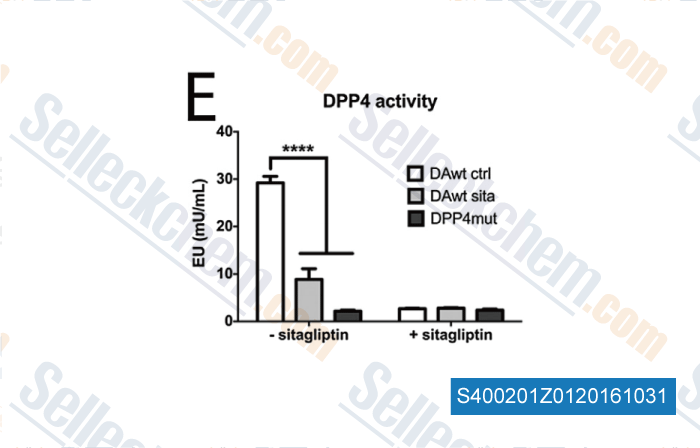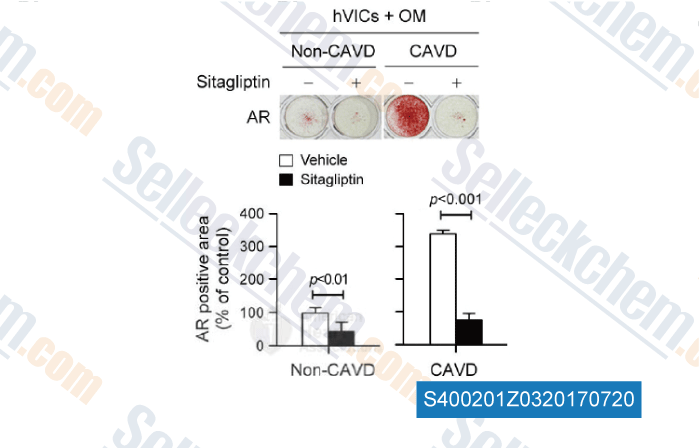|
Toll Free: (877) 796-6397 -- USA and Canada only -- |
Fax: +1-832-582-8590 Orders: +1-832-582-8158 |
Tech Support: +1-832-582-8158 Ext:3 Please provide your Order Number in the email. |
Technical Data
| Formula | C16H15F6N5O.H3PO4.H2O |
|||
| Molecular Weight | 523.32 | CAS No. | 654671-77-9 | |
| Solubility (25°C)* | In vitro | DMSO | 100 mg/mL (191.08 mM) | |
| Water | 41 mg/mL (78.34 mM) | |||
| Ethanol | Insoluble | |||
|
* <1 mg/ml means slightly soluble or insoluble. * Please note that Selleck tests the solubility of all compounds in-house, and the actual solubility may differ slightly from published values. This is normal and is due to slight batch-to-batch variations. * Room temperature shipping (Stability testing shows this product can be shipped without any cooling measures.) |
||||
Preparing Stock Solutions
Biological Activity
| Description | Sitagliptin phosphate monohydrate (MK-0431) is a potent inhibitor of DPP-IV with IC50 of 19 nM in Caco-2 cell extracts. | ||
|---|---|---|---|
| Targets |
|
||
| In vitro | As an orally active agent, Sitagliptin phosphate exhibits a potent inhibitory effect on DPP-4 with IC50 of 19 nM from Caco-2 cell extracts. [1] MK0431 reduces in vitro migration of isolated splenic CD4 T-cells through a pathway involving cAMP/PKA/Rac1 activation. [2] A recent study demonstrates that sitagliptin exerts a novel, direct action in order to stimulate GLP-1 secretion by the intestinal L cell through a DPP-4-independent, protein kinase A- and MEK-ERK1/2-dependent pathway. It therefore reduces the effect of autoimmunity on graft survival. [3] | ||
| In vivo | In vivo, the ED50 value of Sitagliptin phosphate for inhibition of plasma DPP-4 activity is calculated to be 2.3 mg/kg 7 hour postdose and 30 mg/kg 24 hour postdose in freely fed Han-Wistar rats. [1] The streptozotocin-induced type 1 diabetes mouse model exhibits elevated DPP-4 levels in the plasma that can be substantially inhibited in mice on an Sitagliptin phosphate diet. This is achieved by a positive effect on the regulation of hyperglycemia, potentially through prolongation of islet graft survival. [4] The plasma clearance and volume of distribution of Sitagliptin phosphate are higher in rats (40-48 mL/min/kg, 7-9 L/kg) than in dogs (9 mL/min/kg, 3 L/kg); and its half-life is shorter in rats,2 hours compared with 4 hours in dogs. [5] | ||
| Features | A potent, orally active inhibitor of DPP-4. |
Protocol (from reference)
| Kinase Assay:[1] |
|
|---|---|
| Cell Assay:[2] |
|
| Animal Study:[1] |
|
References
Customer Product Validation

-
, , Psychoneuroendocrinology, 2015, 53:195—206

-
Data from [Data independently produced by , , Circulation, 2017, 135(20):1935-1950]
Selleck's Sitagliptin phosphate monohydrate has been cited by 6 publications
| DPP4 Regulates DHCR24-Mediated Cholesterol Biosynthesis to Promote Methotrexate Resistance in Gestational Trophoblastic Neoplastic Cells [ Front Oncol, 2021, 11:704024] | PubMed: 34926239 |
| Anti-glycemic potential of benzophenone thio/semicarbazone derivatives: synthesis, enzyme inhibition and ligand docking studies [ J Biomol Struct Dyn, 2021, 1-12] | PubMed: 33769204 |
| Sitagliptin and the Blood-Retina Barrier: Effects on Retinal Endothelial Cells Manifested Only After Prolonged Exposure [ J Diabetes Res, 2020, 2020:2450781] | PubMed: 32566677 |
| Dipeptidyl Peptidase-4 Induces Aortic Valve Calcification by Inhibiting Insulin-Like Growth Factor-1 Signaling in Valvular Interstitial Cells. [Choi B, et al. Circulation, 2017, 135(20):1935-1950] | PubMed: 28179397 |
| DPP4-deficient congenic rats display blunted stress, improved fear extinction and increased central NPY. [Canneva F, et al. Psychoneuroendocrinology, 2015, 53, 195-206] | PubMed: 25635612 |
| MICE models: superior to the HERG model in predicting Torsade de Pointes. [Kramer J, et al. Sci Rep, 2013, 3:2104] | PubMed: 23812503 |
RETURN POLICY
Selleck Chemical’s Unconditional Return Policy ensures a smooth online shopping experience for our customers. If you are in any way unsatisfied with your purchase, you may return any item(s) within 7 days of receiving it. In the event of product quality issues, either protocol related or product related problems, you may return any item(s) within 365 days from the original purchase date. Please follow the instructions below when returning products.
SHIPPING AND STORAGE
Selleck products are transported at room temperature. If you receive the product at room temperature, please rest assured, the Selleck Quality Inspection Department has conducted experiments to verify that the normal temperature placement of one month will not affect the biological activity of powder products. After collecting, please store the product according to the requirements described in the datasheet. Most Selleck products are stable under the recommended conditions.
NOT FOR HUMAN, VETERINARY DIAGNOSTIC OR THERAPEUTIC USE.
